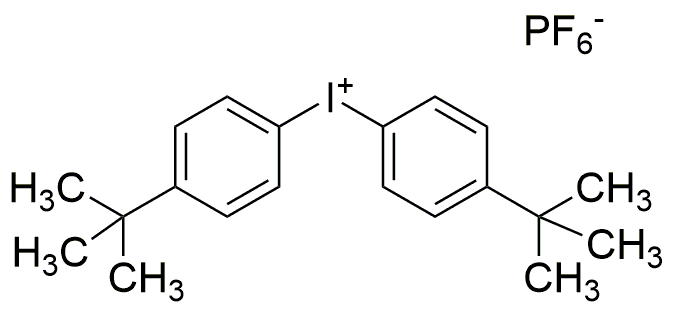Bis(4-tert-butylphenyl)iodonium hexafluorophosphate is widely utilized in research focused on:
- Photoinitiators in Polymer Chemistry: This compound serves as an effective photoinitiator in the curing of polymers, particularly in UV-cured coatings and inks. Its ability to generate free radicals upon exposure to UV light enhances the efficiency of the curing process.
- Electronics Manufacturing: In the electronics industry, it is used in the production of photoresists for semiconductor fabrication. The compound's properties allow for high-resolution patterning, which is crucial for the miniaturization of electronic components.
- Adhesives and Sealants: It is incorporated into formulations for adhesives and sealants, improving their curing speed and performance. This application is particularly beneficial in automotive and construction industries where strong, durable bonds are required.
- Biomedical Applications: The compound is explored for use in biomedical devices, especially in coatings that enhance biocompatibility and reduce bacterial adhesion. This is vital for improving the longevity and safety of medical implants.
- Research in Organic Synthesis: Researchers utilize this chemical in organic synthesis as a reagent for various transformations. Its stability and reactivity make it a valuable tool for developing new compounds in pharmaceutical research.
General Information
Properties
Safety and Regulations
Applications
Bis(4-tert-butylphenyl)iodonium hexafluorophosphate is widely utilized in research focused on:
- Photoinitiators in Polymer Chemistry: This compound serves as an effective photoinitiator in the curing of polymers, particularly in UV-cured coatings and inks. Its ability to generate free radicals upon exposure to UV light enhances the efficiency of the curing process.
- Electronics Manufacturing: In the electronics industry, it is used in the production of photoresists for semiconductor fabrication. The compound's properties allow for high-resolution patterning, which is crucial for the miniaturization of electronic components.
- Adhesives and Sealants: It is incorporated into formulations for adhesives and sealants, improving their curing speed and performance. This application is particularly beneficial in automotive and construction industries where strong, durable bonds are required.
- Biomedical Applications: The compound is explored for use in biomedical devices, especially in coatings that enhance biocompatibility and reduce bacterial adhesion. This is vital for improving the longevity and safety of medical implants.
- Research in Organic Synthesis: Researchers utilize this chemical in organic synthesis as a reagent for various transformations. Its stability and reactivity make it a valuable tool for developing new compounds in pharmaceutical research.
Documents
Safety Data Sheets (SDS)
The SDS provides comprehensive safety information on handling, storage, and disposal of the product.
Product Specification (PS)
The PS provides a comprehensive breakdown of the product’s properties, including chemical composition, physical state, purity, and storage requirements. It also details acceptable quality ranges and the product's intended applications.
Certificates of Analysis (COA)
Search for Certificates of Analysis (COA) by entering the products Lot Number. Lot and Batch Numbers can be found on a product’s label following the words ‘Lot’ or ‘Batch’.
Numéro de catalogue
Numéro de lot/série
Certificates Of Origin (COO)
This COO confirms the country where the product was manufactured, and also details the materials and components used in it and whether it is derived from natural, synthetic, or other specific sources. This certificate may be required for customs, trade, and regulatory compliance.
Numéro de catalogue
Numéro de lot/série
Safety Data Sheets (SDS)
The SDS provides comprehensive safety information on handling, storage, and disposal of the product.
DownloadProduct Specification (PS)
The PS provides a comprehensive breakdown of the product’s properties, including chemical composition, physical state, purity, and storage requirements. It also details acceptable quality ranges and the product's intended applications.
DownloadCertificates of Analysis (COA)
Search for Certificates of Analysis (COA) by entering the products Lot Number. Lot and Batch Numbers can be found on a product’s label following the words ‘Lot’ or ‘Batch’.
Numéro de catalogue
Numéro de lot/série
Certificates Of Origin (COO)
This COO confirms the country where the product was manufactured, and also details the materials and components used in it and whether it is derived from natural, synthetic, or other specific sources. This certificate may be required for customs, trade, and regulatory compliance.


